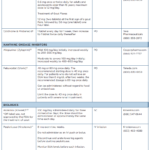Research findings suggest that there are significant knowledge gaps in gout patients regarding these issues.3,4 In the context of a brief medical office visit, it can be difficult to convey all of the information patients need to effectively manage gout.
“Written patient education materials to supplement physician-provided information are helpful references, but they do not replace in-person education that gives patients the opportunity to ask questions and clarify complex medical information,” says Adena Batterman, MSW, LCSW, senior manager, Inflammatory Arthritis Support and Education Programs, HSS.
To address these educational needs, HSS held a multi-disciplinary gout symposium, which was planned with the input of rheumatologists, nurses, a nutritionist and a social worker.
Planning Steps
The first step was to identify gout-specific knowledge gaps and gout patients’ informational preferences to inform content of the symposium. “We developed a 26-item needs assessment to ascertain patient self-efficacy around essential gout-related knowledge and patient-identified needs to enhance self-management,” Ms. Batterman says. The assessment was administered to 100 gout patients.
The symposium content was developed around evidence-based clinical guidelines regarding gout treatment, as well as lifestyle and diet management, and was further informed by the results of the needs assessment. Literacy issues were carefully considered in developing content to ensure information was accessible to a broad audience with varying levels of education and understanding of medical terminology. “The purpose was to provide essential disease and treatment-related information to enhance self-management strategies, which incorporated patient perspective and patient-identified concerns and preferences,” Ms. Batterman says.
‘Diet alone is rarely sufficient [for patients] to reach remission,’ Dr. Fields says. ‘Patients may feel guilty about not adhering to dietary guidelines &, therefore, avoid discussing self-induced flares with their physicians.’
Different Medications for Different Stages
Dr. Fields, a rheumatologist with a specific clinical interest in gout treatment and gout patient education, presented on disease background, etiology, diagnosis and treatment. He emphasized the importance of developing a patient/provider partnership to work together to reduce flares, with the ultimate goal of eliminating flares.
Dr. Fields spent a significant amount of time providing details about the types of medications used to treat gout—why they are used and for how long—and treatment goals for each type, including detailed information about the concept of “bridge therapy” and the need for ULT. Additionally, emphasis was placed on how to control gout flares early in treatment initiation, how to minimize flares and the rationale for long-term, continued treatment, even when attacks seem well controlled. “If the patient understands these points, it can contribute to treatment adherence,” Ms. Batterman says.


